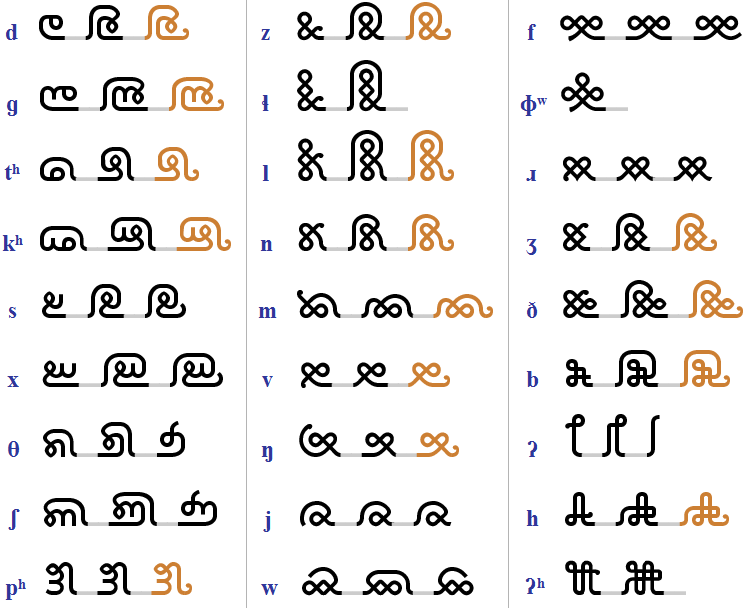This is the 37th version of the SIGIL script, called Slinseng-Fi, which in the Sgai language means “syllables drawn as a thread”. It is a fully cursive development of version 36c, which in turn drew many letter forms and ideas from version 34c. The cursiveness is limited by the grammar (morphology), but usually a whole word or phrase is written with a single stroke.
Main consonants
Compared with other versions of SIGIL script, and the Phonological Cypher series, there is a less interest here in strictly maintaining featural relationships based on phonetics; but there are families of looped forms which often share a phonetic feature. Here the primary consonants are shown with their initial, medial and final forms. Many connected consonant finals are not used in Sgai, but may be useful for transliterating foreign words; they are shown in orange. The medial and final semivowels /j/ and /w/ may also be used as the second element of diphthongs. The generic font shown in the charts is in a demibold “Swiss” style, with uniform strokes. With refinements, it could become quite a pretty script.

Vowels
Schwa is always short, and voiced or unvoiced depending on the voice of the previous consonant; it helps to create sesqui-syllables. It only comes after plosives and may be omitted in writing. The other vowels tend to be long. Many vowels have a specifically final form in writing. Explicit tonemarks may be suffixed in some situations (pure Sgai does not use low or high tone).
Other consonants
There are three medial consonants: the flap, and two special sequences featuring short /ja/ and /wa/, which tend to acquire a high creaky tone (and are rare in requiring two strokes).
The nasalizer follows a vowel and in practice tends to one of the three nasal consonants depending on sandhi with a following consonant. For example, before /b/ the nasalizer will tend to be pronounced /-m/. If the nasalizer is word-final, it sounds as /-ng/.
Long /s/ is a special prefix written with a solo glyph. The double /r/ glyph is a consonant with vocalic extension. Double /n/ is similar, but may also take a tone suffix. The final /t/, /k/ and /kt/ are solo forms. Ejectives are a distinctive feature of Sgai.
Special assemblies
A prefix like a thin T is used before a fricative to signal the arising of an implicit initiating plosive. In almost all cases that will be /d/ or /t/ for voiced and unvoiced fricatives respectively. There is a solo form for /khl/ + vocalic /l/.
There are two ligatures featuring fricative slurs, which in these cases act as grammatical units. Fricative slurs occur quite often in Sgai, as a final fricative meets an initial fricative of a nearby phonemic location.
For certain unvoiced consonants, an inward airflow can be applied. Inward /h/ is basically an inbreath. Symmetrical loop units may be used to show logical divisions.
Numerals
As with all the numeral systems of SIGIL scripts so far, this version’s system is based on joining designated numbers of dots. The main changes from version 34 include ONE and the hexadecimals. A single glyph is used for a set of three zeroes (thousands). Only FIVE, SEVEN and NINE use more than one stroke.

Example
For an example of Sgai using Slinseng-Fi, here is part of a translation of Genesis 11, the Tower of Babel text. The transliteration below it is not IPA, but uses a set of familiar European letters.
[Tower of Babel is the eleventh Genesis story.]
1 And the whole earth was of one language, and of one speech.
2 And it came to pass, as they journeyed from the east, that they found a plain in the land of Shinar; and they dwelt there.
3 And they said one to another, Go to, let us make brick, and burn them thoroughly. And they had brick for stone, and slime had they for mortar.
A version of this page can be found on
Omniglot.





